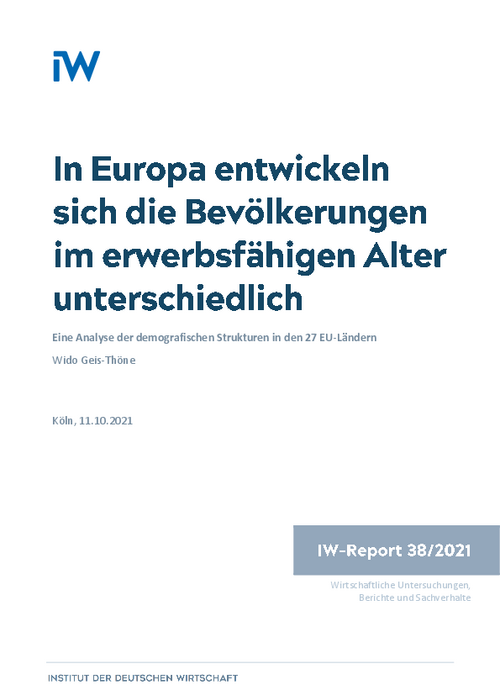If Germany does not succeed in attracting immigrants on a large scale in the next few years, the working-age population will decline sharply. According to the European population projection EUROPOP from 2019, the number of 20–64-year-olds could be 11.2 percent lower in 2030 than in 2020, if there would be no migration. In this case, a decline of only 6.9 percent would be expected in the EU average, and only Lithuania would show a more negative development.

Working Age Populations Develop Differently in Europe: An Analysis of Demographic Structures in the 27 EU Countries

If Germany does not succeed in attracting immigrants on a large scale in the next few years, the working-age population will decline sharply. According to the European population projection EUROPOP from 2019, the number of 20–64-year-olds could be 11.2 percent lower in 2030 than in 2020, if there would be no migration. In this case, a decline of only 6.9 percent would be expected in the EU average, and only Lithuania would show a more negative development.
Particularly problematic with regard to securing skilled labour would be the fact that many of the people leaving the labour force could no longer be replaced by junior employees. For example, on January 1st, 2020, for every 100 people aged 60-64 there were 82 people aged 20-24, but for every 100 people aged 55-59 there were only 59 people aged 15-19 and for every 100 people aged 50-54 there were 56 aged 10-14. The EU averages are 83, 74 and 72 respectively. Very unfavourable trends in working age populations would also be expected in most of the new and southern European member countries, whereas the situation is much better in the northern and western European countries. Nevertheless, the share of the population of working age between 20 and 64 years was significantly lower in France (55.5 percent) than in Germany (59.8 percent). on January 1st, 2020. However, this is due to a much higher proportion of young people who will move into this age group in the next few years.
In the new EU member states the demographic situation is also structurally completely different from that in Germany, despite the similar picture for the working-age population. While strong immigration has significantly mitigated the negative developments in Germany in recent years, the problems in the new EU member states are largely due to population losses caused by emigration. If the countries fail in stopping this to a large extent, targeted immigration promotion is unlikely to be accepted by the population. This is not the case in Southern Europe. However, a large proportion of people of working age are not yet in employment there. Hence, the focus must be on activating the domestic potentials there. Against this backdrop, a common European policy to make provisions for demographic change and secure skilled labour that goes beyond setting a broad framework seems hardly conceivable. Therefore, Germany should go its own way here. Nevertheless, consultations with the other member states on this topic are very important. This applies in particular to how to deal with the one-sided migration movements between the new and old member states, from which Germany has also benefited greatly in recent years.

Working Age Populations Develop Differently in Europe: An Analysis of Demographic Structures in the 27 EU Countries

More on the topic

Securing skilled workers through immigration to universities
Against the backdrop of demographic change, Germany is increasingly dependent on skilled labour from abroad to secure growth and prosperity.
IW
Record immigration not only due to flight from Ukraine
In 2022, more people immigrated to Germany than ever before in the history of the Federal Republic. Around 1.46 million more people moved here than left the country, which is more than a quarter more than the previous record of 1.14 million from 2015.
IW